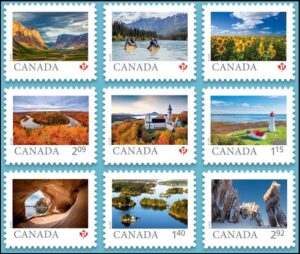
HAPPY CANADA’S 157th BIRTHDAY !
BONNE FÊTE DU CANADA !
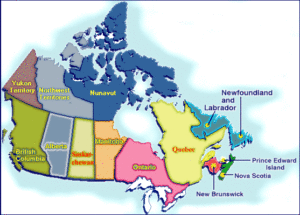
CANADA
www.canada.ca
https://en.wikipedia.org/wiki/Canada
Canada is a country in the northern part of North America. Its ten provinces and three territories extend from the Atlantic to the Pacific and northward into the Arctic Ocean, covering 9.98 million square kilometres (3.85 million square miles), making it the world’s second-largest country by total area. Its southern border with the United States, stretching 8,891 kilometres (5,525 mi), is the world’s longest bi-national land border. Canada’s capital is Ottawa, and its three largest metropolitan areas are Toronto, Montreal, and Vancouver. Official languages: English and French. Population: 41 millions. Monetary Unit: Canadian Dollar. Nunavut is the newest, largest, and most northerly territory of Canada. It was separated officially from the Northwest Territories on April 1, 1999. Capital : Iqaluit.
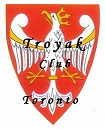
![]()
TROYAK EXECUTIVE TEAM is informing all members, colleagues, collectors, and Polonia at large, that Club meetings taking place at John Paul II Polish Cultural Centre, 4300 Cawthra Rd. (just south of Hwy. 403), Mississauga, Ontario. The new members are always welcome. www.polishculturalcentre.ca
ADRES SPOTKAÑ KLUBOWYCH ! Zarząd Główny Klubu “Troyak” informuje wszystkich członków kolekcjonerów, sympatyków oraz całą Polonię, że spotkania klubowe odbywają się w Polskim Centrum Kultury im. Jana Pawła II, przy 4300 Cawthra Rd. (na południe od autostrady 403), Mississauga, Ontario. Zapraszamy nowych członków do prężnego. Klubu “Troyak”. www.polishculturalcentre.ca
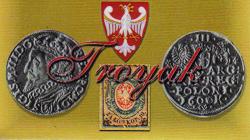
“TROYAK” CLUB NEXT MEETINGS …
NASTĘPNE SPOTKANIA KLUBU “TROYAK” …
July & August 2024 – Summer break … Letnie wakacje …

TROYAK CLUB @ Roncesvalles Polish Festival 2024
Saturday, September 14th, 2024 …
Festival Hours: 11:00am to 11:00pm
Sunday, September 15th, 2024 …
Festival Hours: 11:00am to 7:00pm
https://polishfestival.ca www.kazimierz.org
St. Casimir’s Church

Parish Hall … 156 Roncesvalles Ave. Toronto, Ontario
Stamp Exhibit … Pope John Paul II on World Stamps
and Displays of Coins, Stamps, Collectibles
by Troyak Club Members.
Roncesvalles Polish Festival
www.troyakclub.com
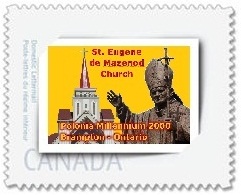
29th September 2024; 27th October 2024
24th November 2024

Sunday – 1st December 2024 @ 9:00 a.m. to 4:00 p.m.
Mississauga Coin & Stamp Show
December 2024 … Happy Holidays!


20. rocznicy przystąpienia Polski do Unii Europejskiej
20th Anniversary of the accession of Poland
to the European Union
www.poczta-polska.pl
W dniu 09 maja 2024 r. został wprowadzony do obiegu znaczek pocztowy w formie bloku o wartości 15,00 zł, emisji “20. rocznica przystąpienia Polski do Unii Europejskiej”. Na znaczku przedstawiono zdjęcie budynku Parlamentu Europejskiego na tle flag Polski i Unii Europejskiej. Wzdłuż górnej krawędzi znaczka umieszczono napis: POLSKA, a w lewym górnym rogu oznaczenie wartości: 15 zł. W grafice bloku tytuł emisji “20. rocznica przystąpienia Polski do Unii Europejskiej” i zarys terytoriów państw tworzących Unię Europejską. Emisji towarzyszy koperta FDC, w grafice której przedstawiono polskie barwy narodowe i fragment tła flagi Unii Europejskiej. Datownik tworzy grafika przedstawiająca flagę Polski.
9 maja obchodzony jest Dzień Europy, święto pokoju i jedności w Europie. Jest to upamiętnienie rocznicy wygłoszenia historycznej deklaracji Roberta Schumana uważanej za symboliczny początek powstania Unii Europejskiej. Emisja jest wspólnym projektem Poczty Polskiej S.A. i Polskiej Wytwórni Papierów Wartościowych SA i stanowi wkład obu spółek w uroczyste świętowanie roku obchodów 20. rocznicy przystąpienia Polski do Unii Europejskiej. Znaczki wydrukowano techniką offsetową, na papierze fluorescencyjnym, w formacie 62,5 x 39,5 mm, w nakładzie 100 000 sztuk, format bloku: 121 x 75 mm; autorka projektu znaczka: Justyna Kopecka. Z tej okazji została również wydana koperta FDC.
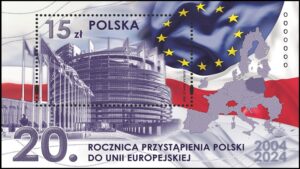
20 lat temu spełniły się pragnienia i oczekiwania pokoleń Polaków żyjących w czasach Europy podzielonej żelazną kurtyną – Polska dołączyła do Unii Europejskiej. W rocznicę tych wydarzeń, Poczta Polska wprowadziła do obiegu wyjątkowy znaczek emisji „20. rocznica przystąpienia Polski do Unii Europejskiej”. Minione lata w europejskiej wspólnocie to czas bezprecedensowego rozwoju naszego kraju. Każdy z nas może podać przykłady spektakularnych zmian w swoim bliższym i dalszym otoczeniu, które korzystnie wpłynęły na codzienne życie i perspektywy rozwoju. Czas pokazał, że dołączenie Polski do Unii Europejskiej to była właściwa decyzja, a Polki i Polacy potrafili i nadal potrafią wykorzystać dane im szanse. Dla uczczenia 20. rocznicy akcesji, Poczta Polska i Polska Wytwórnia Papierów Wartościowych wspólnie przygotowały okolicznościowy znaczek.
PWPW opracowała graficznie projekt waloru, na którym umieszczono zdjęcie Parlamentu Europejskiego w Strasburgu. Wybór budynku Parlamentu Europejskiego jako pierwszoplanowego elementu projektu graficznego nie jest przypadkowy. Podkreślono w ten sposób znaczenie faktu, że posłowie są wybierani przez wszystkich obywateli wspólnoty w powszechnym, bezpośrednim głosowaniu, co czyni tę instytucję najbardziej demokratycznym organem Unii Europejskiej, w pełni ucieleśniającym dewizę UE: „Zjednoczona w różnorodności”. W grafice znaczka w bloku, oprócz budynku Parlamentu Europejskiego zaprezentowano mapę państw tworzących obecnie Unię Europejską. Towarzysząca emisji koperta FDC (Pierwszego Dnia Obiegu) ozdobiona jest splatającymi się flagami Polski i Unii Europejskiej, zaś w datowniku zamieszczona została flaga Polski stylizowana na ryt.
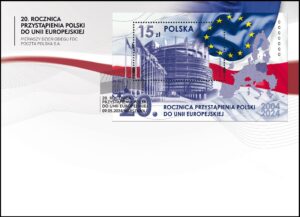
20th Anniversary of the accession of Poland to the European Union … denomination: 15,00 PLN; number of stamps in set: 1 in block; print run: 100 000 pcs; printing techniques: offset; paper: fluorescent; stamp size: 62,5 x 39,5 mm; block size: 121 x 75 mm; number of FDC: 1; stamp designer: Justyna Kopecka; circulation date: 9th May 2024.

80. rocznica bitwy pod Monte Cassino
80th Anniversary of the Battle of Monte Cassino
www.poczta-polska.pl
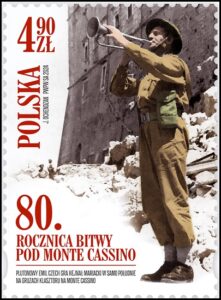
W dniu 18 maja 2024 r. został wprowadzony do obiegu znaczek pocztowy o wartości 4,90 zł emisji “80. rocznica bitwy pod Monte Cassino”. Na znaczku przedstawiono zdjęcie plutonowego Emila Czecha grającego hejnał Mariacki na gruzach klasztoru na Monte Cassino. Znaczki wydrukowano techniką offsetową, na papierze fluorescencyjnym, w formacie 31,25 x 43 mm, w nakładzie 120 000 sztuk, arkusz sprzedażny: 6 znaczków. Z tej okazji została wydana koperta FDC. Autor projektu: Jarosław Ochendzan.
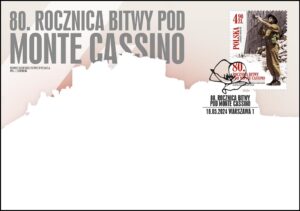
80th Anniversary of the Battle of Monte Cassino … denomination: 4,90 PLN; number of stamps in set: 1; print run: 120 000 pcs; printing techniques: offset; paper: fluorescent; stamp size: 31,25 x 43 mm; 6 stamps in sheet ; number of FDC: 1; author: Jarosław Ochendzan; circulation date: 18th May 2024.

Światowy Dzień Pszczół
World Bee Day
www.poczta-polska.pl
W dniu 20 maja 2024 r. został wprowadzony do obiegu znaczek pocztowy o wartości 4,90 zł, emisji “Światowy Dzień Pszczół”. Światowy Dzień Pszczół, obchodzony od 2018 r., został ustanowiony przez ONZ z inicjatywy Słowenii. Celem jest podkreślenie znaczenia pszczół dla pozyskiwania żywności i zwrócenie uwagi na zagrożenia dla nich. Malejąca populacja wielu gatunków owadów zapylających – przede wszystkim pszczół – jest jednym z kluczowych dla bioróżnorodności problemów. Ponad 87 proc. gatunków roślin na świecie jest zapylanych m.in. przez pszczoły. Powodem ich ginięcia jest nieprawidłowe i zbyt częste stosowanie środków ochrony roślin, wywołujące ich zatrucie. Znaczki wydrukowano techniką offsetową z wykorzystaniem rastra stochastycznego, na papierze fluorescencyjnym, w formacie 40,5 x 40,5 mm, w nakładzie: 125 000 szt. Arkusz sprzedażny zawiera 5 znaczków i przywieszkę. Z tej okazji została wydana koperta FDC. Autor projektu: Andrzej Gosik.
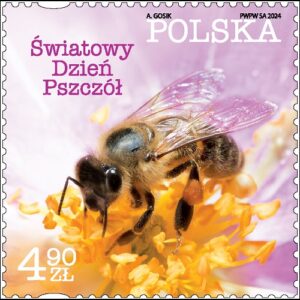
Emisja ma na celu nie tylko upamiętnienie Światowego Dnia Pszczół, ale również zwrócenie uwagi na konieczność ochrony tych niezwykle istotnych dla naszego ekosystemu owadów. Pszczoły odgrywają ważną rolę w zapylaniu roślin, a ponad 87% gatunków roślin na świecie korzysta z ich pracy. Niestety, malejąca populacja pszczół to poważny problem dla bioróżnorodności, którego przyczyną jest m.in. nieprawidłowe stosowanie środków ochrony roślin. Warto także wspomnieć, że pszczoły to nie tylko znakomici zapylacze, ale także producenci miodu, wosku i propolisu, które mają szerokie zastosowanie w medycynie i kosmetyce. Dodatkowo, pszczeli jad wykorzystywany jest w terapiach przeciwzapalnych i przeciwbólowych.
Pamiętajmy, że każdy z nas może wspomóc ochronę pszczół, podejmując proste działania. Pozostawienie w ogrodzie fragmentów trawnika nieskoszonego, gdzie mogą rozwijać się kwietne łąki, stanowi źródło pożywienia dla pszczół i innych zapylaczy. Sadzenie różnorodnych roślin miododajnych, które kwitną w różnych porach roku, zapewnia pszczołom stały dostęp do pożywienia przez cały sezon. Ważna jest także rezygnacja z wypalania traw, łodyg i kwiatów zeszłorocznych, ponieważ stanowią one schronienie dla wielu gatunków owadów, w tym pszczół. Stworzenie miejsc z wodą, wystawianie specjalnych poidełek, szczególnie w słoneczne dni, zawierających drobne kamyczki lub żwirek, pozwala pszczołom na bezpieczne nawodnienie się bez ryzyka utraty życia przez utonięcie. Te pozornie drobne działania mogą mieć ogromny wpływ na zachowanie populacji pszczół i utrzymanie harmonii w przyrodzie.
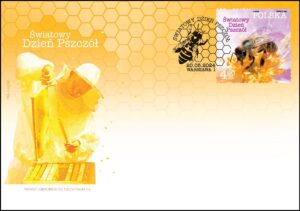
World Bee Day … denomination: 4,90 PLN; number of stamps in set: 1; print run: 125 000 pcs; printing techniques: offset with screen; paper: fluorescent; stamp size: 40,5 x 40,5 mm; number of FDC: 1; author: Andrzej Gosik; circulation date: 20th May 2024.

Europejskie Drzewo Roku 2024
European Tree of the Year 2024
www.poczta-polska.pl
W dniu 22 maja 2024 r. został wprowadzony do obiegu znaczek pocztowy o wartości 1,00 zł emisji “Europejskie Drzewo Roku 2024”. Na znaczku wykorzystano fotografię Bożeny Piotrowskiej przedstawiającą drzewo buk pospolity, który rośnie w Arboretum Wojsławice Ogrodzie Botanicznym Uniwersytetu Wrocławskiego w Niemczy. Na kopercie FDC fotografia drzewa wykonana przez Dawida Słowińskiego. Europejskie Drzewo Roku to międzynarodowy konkurs odbywający się od 2011 roku. Celem Konkursu Europejskie Drzewo Roku jest zwrócenie uwagi na ciekawe stare drzewa, jako ważne elementy dziedzictwa przyrodniczego i kulturowego, które powinniśmy cenić i chronić. W Konkursie Europejskie Drzewo Roku, w odróżnieniu od innych konkursów, decydujące nie jest piękno, rozmiary, czy też wiek, ale historia i związki drzew z ludźmi. Szukamy drzew, które stały się integralną częścią społeczności. Zwycięzcą tegorocznej edycji jest buk pospolity z Polski. Znaczek wydrukowano techniką rotograwiurową, na papierze fluorescencyjnym, w formacie 31,25 x 25,5 mm, w nakładzie 2 000 000 szt., powtarzalnym. Arkusz sprzedażny zawiera 100 znaczków. Z tej okazji została wydana również koperta FDC. Autor projektu znaczka: Poczta Polska S.A.
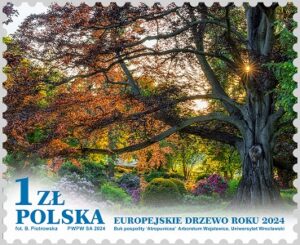
Proekologiczne wydawnictwa filatelistyczne Poczty Polskiej … Warto wspomnieć o innych tegorocznych proekologicznych wydawnictwach Poczty Polskiej promujących ochronę środowiska naturalnego oraz zachęcających do podejmowania szerokich inicjatyw w tym zakresie. Tegoroczna emisja „Europa”, której tematem przewodnim jest podwodna fauna i flora, ma na celu odwrócenie trendu degradacji środowisk wodnych wielkich rzek nizinnych. Wydawnictwo „Ptaki polskich parków” przybliżało nam skrzydlatych mieszkańców parków, natomiast emisja „Owady pożyteczne” propagowała wiedzę na temat bioróżnorodności owadów oraz ich roli w ekosystemie. Zaprezentowany przed kilkoma dniami znaczek „Światowy Dzień Pszczół” podkreśla z kolei znaczenie pszczół dla produkcji żywności oraz zwraca uwagę na zagrożenia dla tych pożytecznych zapylaczy.
Ekologiczne inicjatywy Poczty Polskiej … Poczta Polska, oprócz wydawnictw promujących postawy proekologiczne, wdrożyła szereg projektów mających na celu ochronę środowiska. Dzięki cyfryzacji procesów oraz nowoczesnym formom komunikacji Poczta Polska znacząco zmniejsza zużycie papieru i energii. Wdrożony w 2023 roku program wewnętrzny „Poczta bez papieru” pozwolił ograniczyć drukowanie dokumentów o 26%, oszczędzając 92 740 ryz papieru i 23 tys. tonerów. Digitalizacja procesów usprawniła zadania, przyniosła wymierne oszczędności finansowe i przede wszystkim redukcję śladu węglowego. Firma modernizuje sortownie, inwestuje w nowoczesne maszyny oraz flotę pojazdów elektrycznych, co pozwala na oszczędzanie energii i zmniejszenie emisji CO2. Prowadzi również akcje edukacyjne dla pracowników, zwiększając świadomość ekologiczną.
Tegoroczna inicjatywa „Wybierz nas, posadź Las!” zachęca również klientów do proekologicznych działań. Pracownicy Poczty Polskiej posadzą jedno drzewo za każde 100 przesyłek Pocztex nadanych przez klientów masowych uczestniczących w projekcie. Ekologiczne projekty Poczty Polskiej obejmują także montaż paneli fotowoltaicznych, cyfryzację usług dla klientów oraz wykorzystanie ekologicznych materiałów do pakowania przesyłek. Te działania znacząco przyczyniają się do ochrony środowiska i pozwalają na realizowanie celów związanych z dekarbonizacją. Dzięki takim działaniom Poczta Polska nie tylko promuje świadomość ekologiczną, ale również realnie przyczynia się do ochrony naszego wspólnego środowiska. Razem możemy zrobić wiele dla natury i przyszłych pokoleń.
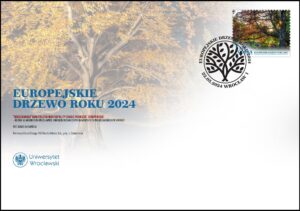
European Tree of the Year 2024 … denomination: 1,00 PLN; number of stamps : 1; print run: 2 000 000 pcs; printing technique: photogravure; paper: fluorescent; stamp size: 31,25 x 25,5 mm; 100 stamps per sheet; number of FDC: 1; author: Poczta Polska S.A.; photo on stamp: Bożena Piotrowska; photo on FDC: Dawid Słowiński; circulation date: 22nd May 2024.

Rośliny chronione
Protected plants
www.poczta-polska.pl
W dniu 27 maja 2024 r. został wprowadzony do obiegu znaczek pocztowy o wartości właściwej do uiszczania opłaty za przesyłkę listową nierejestrowaną ekonomiczną w obrocie krajowym w formacie S i ekonomiczną kartkę pocztową w obrocie krajowym (4,90 zł) emisji “Rośliny chronione”. Na znaczku przedstawiono kwiat mikołajka nadmorskiego.
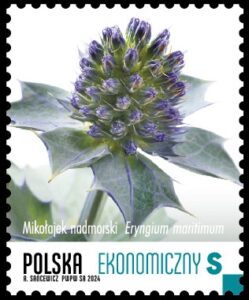
Wzdłuż dolnej krawędzi znaczka umieszczono napisy: POLSKA i EKONOMICZNY S. Znaczek wydrukowano techniką rotograwiurową, na papierze fluorescencyjnym, w formacie 25,5 x 31,25 mm, w nakładzie 8 000 000 szt., powtarzalnym. Arkusz sprzedażny zawiera 100 znaczków. Z tej okazji została wydana również koperta FDC. Autor projektu znaczka: Agnieszka Sancewicz.
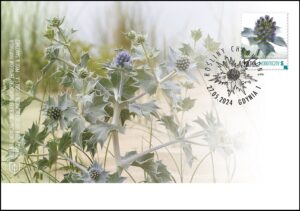
Protected plants … denomination: 4,90 PLN; number of stamps : 1; print run: 8 000 000 pcs; printing technique: photogravure; paper: fluorescent; stamp size: 25,5 x 31,25 mm; 100 stamps per sheet; number of FDC: 1; author: Agnieszka Sancewicz; circulation date: 27th May 2024.

Piękno Polski
The beauty of Poland
www.poczta-polska.pl
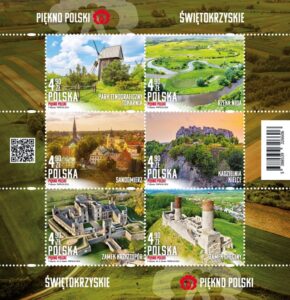
W dniu 27 maja 2024 r. zostało wprowadzonych do obiegu 6 znaczków pocztowych o wartości 4,90 zł każdy, emisji “Piękno Polski”. Na znaczkach przedstawiono piękno ziemi świętokrzyskiej: – na pierwszym- Park Etnograficzny w Tokarni; – na drugim – Panoramę Rzeki Nida;
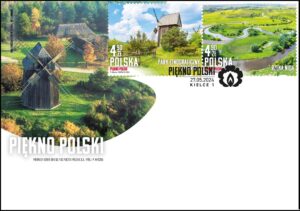
– na trzecim- Panoramę Sandomierza; – na czwartym – Kadzielnię w Kielcach; –
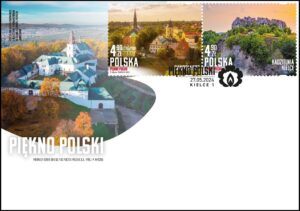
na piątym – Zamek Krzyżtopór; – na szóstym – Zamek w Chęcinach. Na trzech kopertach FDC umieszczono: Park Etnograficzny w Tokarni, Rezerwat Przyrody “Karczówka” z klasztorem pobernardyńskim oraz Góry Pieprzowe. Znaczki wydrukowano techniką offsetową , na papierze fluorescencyjnym, w formacie znaczka 51 x 39,5 mm, format bloku: 149 x 154 mm, w nakładzie 90.000 sztuk każdego znaczka. Blok zawiera 6 znaczków. Autor projektu: Paweł Myszka.

The beauty of Poland … denomination: 4,90 PLN; number of stamps in set: 6; print run: 90.000 pcs. Each; printing techniques: offset; paper: fluorescent; stamp size: 51 x 39,5 mm; block size: 149 x 154 mm; number of FDC: 3; author: Paweł Myszka; circulation date: 27th May 2024.


100. rocznica wprowadzenia złotego do obiegu
www.nbp.pl
Emisja wartości kolekcjonerskich stanowi okazję do upamiętniania ważnych historycznych rocznic i postaci oraz do rozwijania zainteresowań polską kulturą, nauką i tradycją. 25 kwietnia 2024 roku Narodowy Bank Polski wprowadził do obiegu srebrną monetę o nominale 1 zł „100. rocznica wprowadzenia złotego do obiegu”.
Nominał: 1 zł … Metal: Ag 999/1000; Stempel: lustrzany, selektywne złocenie; Wymiary: 40,00 × 40,00 mm; Masa: 28,28 g; Brzeg (bok): gładki; Nakład: do 10 000 szt.; Projektantka: Urszula Walerzak; Emitent: NBP Na zlecenie NBP monety wyprodukowała Mennica Polska SA.
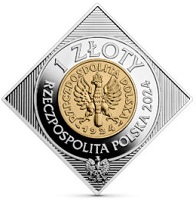
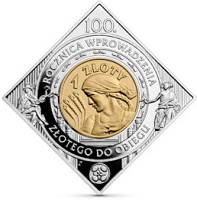
Rewers monety przedstawia wizerunek rewersu monety o nominale 1 zł z 1924 r. Na monecie umieszczono także wizerunek fragmentu portalu nad wejściem do głównej sali Banku Polskiego SA w Warszawie oraz elementy graficzne banknotu o nominale 100 zł z 1934 r.: po lewej stronie alegoria handlu w postaci Merkurego z kaduceuszem, po prawej stronie personifikacja przemysłu. Na awersie monety znajduje się wizerunek awersu monety o nominale 1 zł z 1924 r.
Po odzyskaniu niepodległości w listopadzie 1918 r. bardzo szybko podjęto decyzję o utworzeniu nowego banku emisyjnego oraz wprowadzeniu nowej waluty polskiej – złotego. Wysiłek związany z odbudową państwa oraz konieczność walki o granice uniemożliwiły jednak szybkie wdrożenie zmian. Dodatkowo niemal od samego początku istnienia odrodzone państwo polskie musiało zmagać się z rosnącą inflacją, która w drugiej połowie 1923 r. przerodziła się w hiperinflację. Nastał kryzys gospodarczy, a sytuacja społeczno-polityczna była bardzo napięta. W grudniu 1923 r. powstał rząd Władysława Grabskiego, którego gabinet stanął przed zadaniem przeprowadzenia reformy skarbowej i walutowej. Sejm udzielił rządowi specjalnych pełnomocnictw. Dokonano licznych oszczędności, nałożono daniny majątkowe, urealniono podatki, energicznie rozpoczęto walkę z inflacją oraz przeprowadzono sanację systemu bankowego. Dzięki działaniom naprawczym udało się ustabilizować kurs dotychczasowej waluty – marki polskiej. Zwiększono rezerwy dolarowe, które wraz ze zgromadzonymi zapasami złota miały stanowić zabezpieczenie nowej waluty.
Złoty zadebiutował w kwietniu 1924 r. Jego wartość została dokładnie skalkulowana. Nowa polska waluta opierała się na parytecie złota i walut wymienialnych. 1 złoty stanowił równowartość 9/31 g złota, 100 złotych odpowiadało wartości jednej uncji trojańskiej, zaś 1 kg kruszcu kosztował 3 444 złote. 1 dolar był wart 5,18 złotego, a wartość polskiego pieniądza została związana z frankiem szwajcarskim. Ustalono, że nowa waluta musi mieć pokrycie w złocie i walutach obcych przynajmniej w 30%. Równocześnie podjęto decyzję o wycofaniu z obiegu dotychczasowego środka płatniczego. Kurs wymiany określono na 1 800 000 marek polskich za 1 złotego. Za emisję złotego odpowiedzialny był Bank Polski Spółka Akcyjna, nowo powołany bank emisyjny, który zastąpił Polską Krajową Kasę Pożyczkową, instytucję utworzoną jeszcze przez okupanta niemieckiego w okresie I wojny światowej. Reforma okazała się wielkim sukcesem, ponieważ nie tylko zaowocowała uzdrowieniem finansów publicznych, lecz stanowiła także impuls do rozwoju gospodarczego państwa. Jej efektem było również znaczne wzmocnienie pozycji Polski na arenie międzynarodowej. Informacja: dr Grzegorz Jeż.

100th Anniversary of Putting the Zloty into Circulation
www.nbp.pl
Issuing collector items is an occasion to commemorate important historic figures and anniversaries, as well as to develop the interest of the public in Polish culture, science and tradition. On 25 April 2024, Narodowy Bank Polski issued into circulation a silver coin “100th Anniversary of Putting the Złoty into Circulation”, with a face value of 1 złoty.
Face value: 1 zł … Metal: Ag 999/1,000; Finish: proof, selective gilding; Diameter: 40.00 × 40.00 mm; Weight: 28.28 g; Edge (side): plain; Mintage: up to 10,000 pcs; Designer: Urszula Walerzak; Issuer: Narodowy Bank Polski, The coins, commissioned by Narodowy Bank Polski, were struck by Mennica Polska SA.


The reverse of the coin shows the image of the reverse of a 1924 coin with a face value of 1 złoty. The 2024 coin also depicts the image of a fragment of a portal above the entrance to the main hall of Bank Polski SA in Warsaw and graphic elements of a 100 złoty banknote issued in 1934: on the left side, there is the allegory of commerce in the form of Mercury holding a caduceus staff, and dr Grzegorz Jeż on the right side, the personification of industry. The obverse of the coin features the obverse of the 1924 coin with a face value of 1 złoty.
After Poland regained independence in November 1918, the decision was taken swiftly to establish a new bank of issue and introduce a new Polish currency, the złoty. However, the effort put into the reconstruction of the state and the need to fight the war on the country’s borders made a speedy implementation of the reforms impossible. In addition, since the very start of its existence the reborn Polish state had to fight rising inflation, which morphed into hyperinflation in the second half of 1923. An economic crisis set in, and the social and political situation was very tense. In December 1923, the Władysław Grabski government was formed and the cabinet faced the task of carrying out the fiscal and currency reforms. The Sejm (Polish parliament) granted the government special powers. The government managed to make a number of savings, impose levies on real estate, adjust the taxes, start to actively fight inflation and reform the banking system. Thanks to the recovery programme, it was possible to stabilise the exchange rate of the Polish mark, the then Polish currency. There was an increase in US dollar reserves, which along with the country’s gold stocks, were supposed to back the new currency.
The złoty was first put into circulation in April 1924 and its value was carefully calculated. The new Polish currency was based on the parity of gold and convertible currencies. One złoty was the equivalent of 9/31 grams of (pure) gold; 100 złoty was equal in value to 1 troy ounce, and the price of 1 kilogram of gold amounted to 3,444 złoty. One US dollar cost 5.18 złoty, and the value of the Polish currency was pegged to the Swiss franc. According to the reform arrangements, at least 30% of the issue of the new Polish currency had to be backed by gold stocks and foreign currencies. At the same time, the decision was made to withdraw the existing means of payment. The exchange rate was set at 1,800,000 Polish marks for 1 złoty. The issue of the złoty was within the remit of Bank Polski Spółka Akcyjna (a joint stock company), the newly established bank of issue which replaced the Polish Loan Bank (Polska Krajowa Kasa Pożyczkowa), the institution set up by the German occupant during World War I. The reform proved to be an outstanding success, because it not only led to the consolidation of public finances, but also provided an impulse for the country’s economic development. The reform also resulted in a significant strengthening of Poland’s position on the international arena. Info: Grzegorz Jeż, PhD.


230. rocznica insurekcji kościuszkowskiej
www.nbp.pl
Narodowy Bank Polski jest centralnym bankiem państwa odpowiadającym za politykę pieniężną i stabilność cen. Jego funkcje określa Konstytucja Rzeczypospolitej Polskiej i ustawa o NBP. NBP ma wyłączne prawo emisji pieniądza. Jako bank centralny nie prowadzi rachunków bankowych obywateli, nie przyjmuje od nich lokat, nie udziela kredytów. Prowadzi natomiast obsługę budżetu państwa, a także podmiotów sektora finansów publicznych. Gromadzi rezerwy walutowe państwa i zarządza nimi. Pełni funkcję banku banków, tworząc warunki do działania systemu bankowego. Jest również jednym z najważniejszych ośrodków naukowo-analitycznych w dziedzinie ekonomii i rynków finansowych.
Emisja wartości kolekcjonerskich stanowi okazję do upamiętniania ważnych historycznych rocznic i postaci oraz do rozwijania zainteresowań polską kulturą, nauką i tradycją. 14 maja 2024 roku Narodowy Bank Polski wprowadził do obiegu złotą monetę o nominale 100 zł oraz srebrną monetę o nominale 50 zł „230. rocznica insurekcji kościuszkowskiej”.
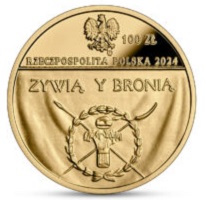
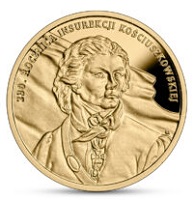
Nominał 100 zł … metal: Au 900/1000; stempel: lustrzany; średnica: 21,00 mm; masa: 8,00 g; brzeg (bok): gładki; nakład: do 1200 szt.; Projektantka: Dominika Karpińska-Kopiec.
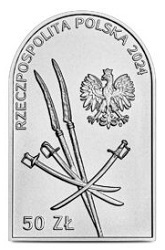
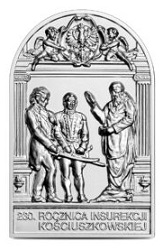
Nominał 50 zł … metal: Ag 999/1000; stempel: zwykły, wysoki relief; wymiary: 32,00 × 50,00 mm; masa: 62,20 g; brzeg (bok): gładki; nakład: do 6000 szt.; Projektantka: Dobrochna Surajewska; Emitent: NBP Na zlecenie NBP monety wyprodukowała Mennica Polska SA
Celami insurekcji kościuszkowskiej były „wolność, całość, niepodległość” Rzeczypospolitej. Decyzję o powstaniu podjęli, na wieść o II rozbiorze, przywódcy Sejmu Czteroletniego, przebywający na emigracji. Przeznaczony na naczelnika insurekcji Tadeusz Kościuszko, bohater wojny o niepodległość Stanów Zjednoczonych oraz wojny z Rosją w 1792 r., zabiegał o wsparcie ze strony rewolucyjnej Francji – bezskutecznie. W kraju szerzył się spisek, zarówno w armii, jak i wśród cywilów. Sygnałem powstańczym stał się wymarsz brygady gen. Antoniego Madalińskiego z Ostrołęki na południe w nocy z 12 na 13 marca 1794 r. Brygada miała ściągnąć na siebie rosyjskie wojska, by w wolnym dzięki temu Krakowie mógł wystąpić Kościuszko. 24 marca 1794 r., po mszy św. i poświęceniu pałaszy, generał złożył przysięgę na Rynku Głównym i został naczelnikiem powstania. Szanse insurekcji zależały od udziału w niej, prócz szlachty, także mieszczan, a zwłaszcza grupy najliczniejszej – chłopów. Stoczona 4 kwietnia bitwa pod Racławicami, zwycięska dzięki atakowi kosynierów na armaty wroga, pokazała, że Rosjan można pokonać.
Kościuszko w chłopskiej sukmanie apelował o wstępowanie ludu do armii. 7 maja pod Połańcem wydał uniwersał nadający chłopom wolność osobistą, zwalniający uczestników walk z pańszczyzny oraz przynoszący w niej ulgi pozostałym włościanom. Choć udział chłopów w insurekcji nie stał się masowy, hasło kosynierów „Żywią i bronią” wyrażało współodpowiedzialność włościan za losy ojczyzny, a z czasem stało się dewizą ruchu ludowego. Insurekcja warszawska 17 i 18 kwietnia uwolniła miasto od Rosjan. Pięć dni później powstanie objęło Litwę. Kościuszko dotarł z armią do stolicy u schyłku czerwca. Rosja i Prusy zdecydowały wówczas o oblężeniu Warszawy i zduszeniu insurekcji. Do końca sierpnia ataki na miasto nie zdołały złamać oporu obrońców. Gdy na wezwanie Kościuszki do walk włączyła się Wielkopolska, na początku września Fryderyk Wilhelm II wycofał swe korpusy spod Warszawy, by bronić ziem zagarniętych w II rozbiorze. Cofnęli się także Rosjanie – stolica była wolna. Dysproporcja sił insurekcji i zaborców pozostawała jednak ogromna. Los Polski rozstrzygnęła bitwa pod Maciejowicami 10 października 1794 r.
Kościuszko wyruszył tam, by uderzyć na rosyjski korpus, zanim dołączy do niego kolejny. W walce z liczniejszym wrogiem naczelnik poniósł klęskę i ranny dostał się do niewoli. Armia Aleksandra Suworowa, zdobywszy Pragę, dokonała 4 listopada rzezi jej cywilnych mieszkańców. Sterroryzowana tym Warszawa skapitulowała 9 listopada 1794 r. Klęska insurekcji oznaczała ostateczny rozbiór Polski. Na awersie monety srebrnej zostały umieszczone symbole powstańczych walk – szlacheckie szable i chłopskie kosy. Na rewersie monety srebrnej znajduje się wizerunek płaskorzeźby Alfreda Dauna z 1896 r., przedstawiającej święcenie pałaszy generałów Tadeusza Kościuszki i Józefa Wodzickiego. Płaskorzeźba jest umieszczona na murze domku loretańskiego przy klasztorze oo. kapucynów w Krakowie. Na awersie monety złotej zaprezentowano sztandar chorągwi kosynierów krakowskich z nadaną mu przez Kościuszkę dewizą „Żywią i bronią” – wizerunek sztandaru z pisownią ówczesną ze zbiorów Muzeum Wojska Polskiego w Warszawie. Na rewersie monety złotej widnieje portret Tadeusza Kościuszki z polskim Orderem Virtuti Militari oraz amerykańskim Orderem Cyncynata – na podstawie stalorytu Antoniego Oleszczyńskiego z 1829 r. Informacja: Zofia Zielińska.

230th Anniversary of the Kościuszko Insurrection
www.nbp.pl
Narodowy Bank Polski is the central bank of the State, responsible for its monetary policy and price stability. The Bank’s functions are described in the Constitution of the Republic of Poland and the Act on NBP. NBP holds the exclusive right to issue the currency of the Republic of Poland. As the central bank, it does not provide accounts for the general public, accept deposits from or extend loans to individuals. It acts as a banker to the State budget and public sector entities. NBP also holds and manages the foreign exchange reserves of the State. Finally, it functions as a banker to banks, creating conditions for the operation of the Polish banking system. Narodowy Bank Polski is one of the most important research and analytical centres in the fields of economics and financial markets.
Issuing collector items is an occasion to commemorate important historic figures and anniversaries, as well as to develop the interest of the public in Polish culture, science and tradition. On 14 May 2024, Narodowy Bank Polski issued into circulation a gold coin with a face value of 100 złoty and a silver coin with a value of 50 złoty – “230th Anniversary of the Kościuszko Insurrection”.


Face value: 100 zł … Metal: Au 900/1000; Finish: proof; Diameter: 21.00 mm; Weight: 8.00 g; Edge (side): plain; Mintage: up to 1,200 pcs; Designer: Dominika Karpińska-Kopiec.


Face value: 50 zł … Metal: Ag 999/1000; Finish: standard, high relief; Diameter: 32.00 x 50.00 mm; Weight: 62.20 g; Edge (side): plain; Mintage: up to 6,000 pcs; Designer: Dobrochna Surajewska; Issuer: Narodowy Bank Polski; The coins, commissioned by Narodowy Bank Polski, were struck by Mennica Polska SA.
The objectives of the Kościuszko Insurrection were the ”freedom, territorial integrity and independence” of the Polish-Lithuanian Commonwealth. The decision to start an insurrection was made by the exiled leaders of the Four-Year Sejm, on hearing about the Second Partition of the country. Tadeusz Kościuszko, hero of the American Revolution and the war with Russia of 1792, who was designated to lead the uprising, sought support from revolutionary France, but to no avail. Conspiracy spread across the country among the military and civilians alike. General Madaliński brigade’s march from Ostrołęka to the south on the night of 12 March 1794 was a signal to start the insurrection. The brigade was to draw Russian troops away from Kraków so that Kościuszko could speak in the ancient Polish capital. On 24 March 1794, after a holy mass and the blessing of backswords, the general took an oath in the Main Square and became the commander of the uprising. The chances for the success of the insurrection hinged on the participation – apart from the gentry – of townspeople and, more importantly, peasantry, which was the most numerous social class. The Battle of Racławice of 4 April, which ended in victory thanks to the attack of scythemen on the enemy’s cannons, showed that the Russians could be defeated.
Kościuszko, wearing a peasant’s coat, appealed to the people to join the army. On 7 May near Połaniec, he issued a proclamation granting peasants personal freedom, releasing the combatants from serfdom and reducing serfdom for other peasants. Although the participation of peasants in the uprising never became a mass movement, the Kościuszko’s slogan “They feed and defend” expressed the co-responsibility of peasants for the fate of the homeland, and over time became the motto of the peasant movement. The Warsaw insurrection of 17 and 18 April liberated the city from Russians. Five days later, the uprising spread into Lithuania. Kościuszko and his army reached the capital city in late June. Then, Russia and Prussia decided to lay siege to Warsaw and suppress the insurrection. Attacks on the city mounted until the end of August did not succeed in breaking the resistance of the defenders. When the province of Greater Poland joined the fight upon Kościuszko’s call to arms, Frederick William II of Prussia withdrew his troops from Warsaw to defend the land captured during the Second Partition of Poland. The Russians also retreated and the capital city was free. However, the disproportion between the forces of the insurrection and the invaders remained tremendous. Poland’s fate was decided at the Battle of Maciejowice on 10 October 1794.
Kościuszko had moved there to attack a Russian corps before it was joined by another. Outnumbered by the enemy, the Polish troops were defeated and their commander, wounded, was taken prisoner. Aleksandr Suvorov’s army captured the Warsaw suburb of Praga and on 4 November massacred its civilian inhabitants. Terrorised by this atrocity, Warsaw capitulated on 9 November 1794. The defeat of the insurrection entailed the final partition of Poland. The obverse of the silver coin features symbols of the uprising’s battles – noblemen’s sabres and peasants’ upright scythes.
On the reverse of the silver coins, there is an image of the 1896 relief by Alfred Daun showing the blessing of the backswords of General Tadeusz Kościuszko and General Józef Wodzicki. The original relief is located on the wall of the Loreto house in the Capuchin Monastery in Kraków. The obverse of the gold coin has the banner of the Krakow scythemen regiment, with the motto “Żywią i bronią” [They feed and defend] given to it by Kościuszko, as it was originally spelled. The banner is an exhibit in the Polish Army Museum in Warsaw. The reverse of the gold coin shows a portrait of Tadeusz Kościuszko with the Polish Virtuti Militari Order and the US Order of Cincinnatus, based on the steel engraving by Antoni Oleszczyński from 1829. Info: Zofia Zielińska.


Royal Canadian Air Force (RCAF)
100th Anniversary Commemorative Envelope
www.canadapost.ca
About the Royal Canadian Air Force … In 2024, the Royal Canadian Air Force (RCAF) marks its 100th anniversary as a distinct branch of the Canadian military. While thousands of Canadians served in Britain’s flying services during the First World War, it wasn’t until after the war that military aviation became a permanent part of Canada’s defence organization. In 1920, a part-time Canadian Air Force was authorized by an Order-in-Council.
After receiving the “Royal” designation from King George V, it became a permanent component of Canada’s defence force, on April 1, 1924. The RCAF went on to play a key role in the Allied victory in the Second World War and has since contributed to major Canadian deployments in Europe, Africa, the Middle East and Asia. Today, the RCAF is tasked with defending and protecting Canadian and North American airspace and contributes to international peace and security through its commitments to organizations such as the North American Aerospace Defense Command (NORAD) and the North Atlantic Treaty Organization (NATO). The RCAF also serves at home, providing such capabilities as search and rescue and assistance to communities affected by natural disasters.

About the design … The RCAF 100th anniversary commemorative envelope features a collage of photographs, most provided by the Department of National Defence. The photos provide a historical overview of the aircraft and varied work of the RCAF throughout the past 100 years. The back of the envelope features the RCAF’s roundel, a red maple leaf surrounded by white in a blue ring. The maple leaf was introduced in the roundel in 1940, replacing a red centre, and began to appear on RCAF aircraft in 1946. The current design, with a stylized 11-point maple leaf, dates back to 1965.
The stamp chosen for the RCAF commemorative envelope features William George Barker, VC, and was originally issued as part of the 2019 edition of the Canadians in Flight series. William Barker was the first acting director of the RCAF. The cancel location is Borden, Ontario, home to Canadian Forces Base Borden (CFB Borden), which was the birthplace of the RCAF. The cancel image features a black and white rendition of the RCAF’s roundel. Stamp Designer: Sputnik; Quantity Produced: 10,000; Issue Date: April 2, 2024.


Endangered Frogs: Permanent™ domestic rate stamps
www.canadapost.ca
Take home this booklet of 10 Permanent™ domestic rate stamps that features two endangered frog species found in Canada – the Oregon spotted frog (Rana pretiosa) and Fowler’s toad (Anaxyrus fowleri). The two stamps feature illustrations of the Oregon spotted frog and Fowler’s toad.
About the issue … These two frog species face many threats, including loss of habitat from human activity, invasive organisms and pollutants. Canada Post has a longstanding tradition of showcasing Canadian wildlife and using stamps to raise awareness of the impacts of human activity on animal populations. Examples include Endangered Turtles (2019), Bears (2019), Endangered Whales (2022) and Animal Mothers and Babies (2023).
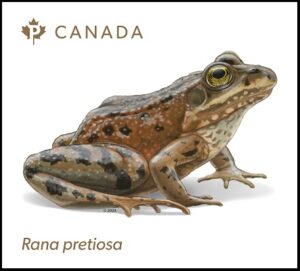
Oregon spotted frog (Rana pretiosa) … Oregon spotted frogs are brown or reddish-brown with light‑centred black spots on their heads, backs, sides and legs. They also have two dorsolateral folds, which are ridges of glandular skin that run down each side of the back. Adult Oregon spotted frogs look like they have been painted orange to brick red on their bellies, thighs and sides, whereas juveniles have white bellies that become increasingly red as they mature. Adults can grow up to 10 centimetres in length, and females are larger than males. In Canada, Oregon spotted frogs are found exclusively in British Columbia’s Fraser Valley.
They are also found in the United States – in a small number of sites in Washington and Oregon. It is extirpated from California. These frogs spend most of their time in the water. The webbing on their hind feet extends to the tip of their toes, making them efficient swimmers. Unlike most other frogs, their eyes are angled upward, which helps them to remain almost entirely submerged while still able to see above water. Inhabiting warm, shallow wetlands with emergent and floating vegetation, Oregon spotted frogs eat a variety of insects such as beetles and flies, as well as spiders and other invertebrates. The tadpoles eat algae, decaying plant matter and detritus.

Fowler’s toad (Anaxyrus fowleri) … Fowler’s toads are grey to buff coloured above, with small dark spots and warts on the back, and a white or cream-coloured belly. Males have a dark-coloured throat, while females’ throats are white. Adults range in size from about 5 cm to over 8 cm in length. In Canada, Fowler’s toads are found only on the north shore of Lake Erie (in Ontario), on sandy beaches and dunes. They breed in shallow ponds, pools and marshes. They are also found in much of the eastern United States. Primarily nocturnal, adult Fowler’s toads mainly eat insects and other small terrestrial invertebrates, while tadpoles consume mainly algae and aquatic plants. The male’s call has been likened to a shrill scream or agonized wail.
About the design … The two stamps feature illustrations of the Oregon spotted frog and Fowler’s toad. The booklet front cover features an image of a Fowler’s toad. The outside left panel shows a male Fowler’s toad with its vocal sac inflated to amplify its mating calls. The image on the inside left panel shows an Oregon spotted frog eating a northern bluet (a species of damselfly), one of the insects in its diet. The illustrations on the inside right panel show the life cycle of the Oregon spotted frog (top) and of Fowler’s toad (bottom), from egg, through tadpole, to full-grown frog or toad. The colour bars depict tadpoles. Stamp Value: Permanent™ domestic rate; Stamp Designer: Jocelyne Saulnier, Joce Creative; Stamp Illustrator: Emily S. Damstra; Quantity Produced: 250,000 booklets; Issue Date: April 15, 2024.
This Souvenir sheet that features two endangered frog species found in Canada – the Oregon spotted frog (Rana pretiosa) and Fowler’s toad (Anaxyrus fowleri). The two stamps feature illustrations of the Oregon spotted frog and Fowler’s toad. The two stamps feature illustrations of the Oregon spotted frog and Fowler’s toad. The background image shows an Oregon spotted frog peeking up above the surface of marshy waters. Stamp Value: Permanent™ domestic rate; Stamp Designer: Jocelyne Saulnier, Joce Creative; Stamp Illustrator: Emily S. Damstra; Quantity Produced: 40,000; Issue Date: April 15, 2024.
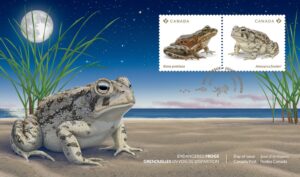
This Official First Day Cover that features two endangered frog species found in Canada – the Oregon spotted frog (Rana pretiosa) and Fowler’s toad (Anaxyrus fowleri). The OFDC shows the nocturnal Fowler’s toad on a sandy Lake Erie shore at nighttime. The Official First Day Cover features an illustration of the nocturnal Fowler’s toad on a sandy Lake Erie shore at nighttime. The cancel location is Port Rowan, a town on the north shore of Lake Erie that is close to the habitat of Fowler’s toad. The cancel features a simplified image of the frog life cycle from egg to adult. Cancellation Site Port Rowan, ON; Stamp Value: Permanent™ domestic rate; Stamp Designer: Jocelyne Saulnier, Joce Creative; Stamp Illustrator: Emily S. Damstra; Quantity Produced: 6,000; Issue Date: April 15, 2024.

2024 Canada Post Community Foundation:
Permanent™ domestic rate stamps –
booklet of 10 + $1 donation
www.canadapost.ca
Wise people say that a life well lived is about the journey, not the destination. As such, it is important to have travelling companions who will inspire you to soar as high as you can imagine. Through the Canada Post Community Foundation annual semi-postal fundraising stamp issue, you can rise up to support and encourage young people. Your donation of $1 from this booklet of 10 stamps goes directly to the Foundation to fund local and national nonprofit groups that assist Canadian children and youth. Together, we can help their dreams take flight.
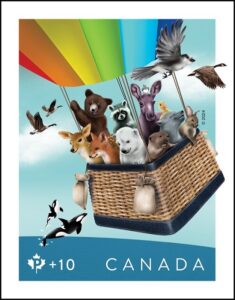
This year’s stamp design, designed and illustrated by Seung Jai Paek, is an illustration depicting a diverse group of animals flying in a hot air balloon – a reminder of the ways we can uplift, inspire and support young people to soar as high as they can imagine and the ways we can fuel their dreams to take flight. Stamp Designer: Seung Jai Paek; Stamp Value: Permanent™ domestic rate plus the 10-cent surcharge on each stamp; Issue Date: April 29, 2024.
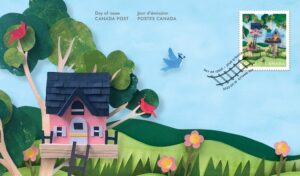
When you purchase this Official First Day Cover, a donation of 10 cents from the stamp affixed will go to fund local and national non-profit groups that assist Canadian children and youth in writing the next chapter of their lives. Official First Day Cover, cancelled in Ottawa, Ontario. Issue Date: April 29, 2024.


2024 … Pure Silver – Wildlife Reflections
Three-Coin set: Grizzly Bear (1)
www.mint.ca
New for 2024, the three-coin Wildlife Reflections series celebrates Canada’s natural beauty through colourful, texturally enhanced depictions of three of this nation’s most iconic wildlife species: the grizzly bear, cougar and moose. Each coin captures a contemplative moment in the wild and highlights each species’ awe-inspiring qualities, reflecting their majesty alongside the grandeur of the Canadian wilderness. It’s the next-best thing to being in the great outdoors! The wildlife highlighted in this series are some of the most widely recognized animals in Canada, which is home to an estimated 80,000 species.
First coin in a new series! The Wildlife Reflections series celebrates Canada’s natural beauty through colourful, texturally enhanced depictions of Canadian fauna, beginning with the grizzly bear (Coin #1).
Few mammals are as closely associated with the forested regions of western and northern Canada as the grizzly bear, a true icon of these wild spaces. Ursus arctos is Canada’s largest land-based carnivore, and while its strength is indisputable, this coin’s reverse inspires awe by showcasing a quiet moment at sunrise – and by presenting the mighty grizzly and its salmon prey as a reflection of the ecosystems they inhabit.
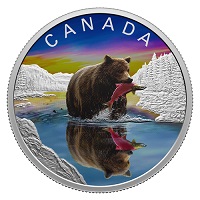
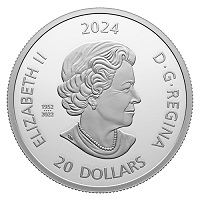
Face Value: 20 dollars … Composition: 99.99% pure silver; Mintage: 7,500; Weight: 31.39 g; Diameter: 38 mm; Edge: Serrated; Finish: Proof; Artist: Claude Thivierge (reverse); Susanna Blunt (obverse); Packaging: Black clamshell with black beauty box.
DID YOU KNOW? … *** Canada is home to up to 26,000 grizzly bears, with more than half of the population residing in British Columbia—the rest can be found in forested regions of Alberta and the three territories.
Designed by wildlife artist Claude Thivierge, your coin’s reverse features a colourful sunrise that sets the tone for a peaceful river scene, with engraved mountains and forests providing a captivating backdrop. Selective colour extends to both the grizzly bear and its salmon prey, and to their reflection in the water below, while a multi-texture effect mimics the look of fur and creates a shimmering effect on the surface of the water. The obverse features the effigy of Queen Elizabeth II by Susanna Blunt. The obverse also bears a special marking that includes four pearls symbolizing the four effigies that have graced Canadian coins and the double date of her reign.
Claude Thivierge, Artist … “I wanted to create a lively coin that would radiate strength and pride. The vibrant colours in the background truly showcase the grizzly bear’s intense, raw power. It is a captivating depiction of an impressive predator’s proud nature. It also highlights the grizzly’s salmon fishing skills, showcased on this coin with a magnificent pop of colour.”
Alicia Cook Sapene, Product Manager … “Home to an incredible diversity of life, the Canadian wilderness is a place of perpetual beauty—a place where discoveries and unexpected encounters can provide soul-stirring moments of tranquility and reflection. With this series, I set out to celebrate Canada’s natural beauty through colourful yet contemplative portraits, and Claude brought this vision to life with his depictions of iconic wildlife in equally iconic settings.”

Pure Silver Coin – Wildlife Reflections: Cougar (2)
www.mint.ca
Coin #2 offers you an extraordinary encounter with Canada’s largest wild cat. The Wildlife Reflections series celebrates Canada’s natural beauty through colourful, texturized depictions of Canadian fauna, and Coin #2 presents a contemplative portrait of Puma concolor. Canada’s largest wild cat, the strong and stealthy cougar is steady on its feet. While this secretive forest-dweller may roam at any time, it tends to be most active from dusk until dawn—a fact that is reflected in the stunning sunset re-created on your coin’s reverse, which elicits reverence for this enigmatic big cat and its habitat.
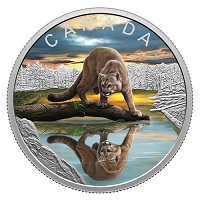
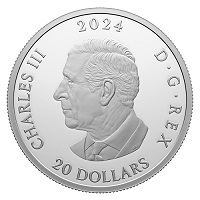
Face Value: 20 dollars … Composition: 99.99% pure silver; Mintage: 7,500; Weight: 31.39 g; Diameter: 38 mm; Edge: Serrated; Finish: Proof; Artist: Claude Thivierge (reverse); Steven Rosati (obverse); Packaging: Black clamshell with black beauty box.
DID YOU KNOW? … ***Because of the cougar’s elusive nature, it’s difficult to estimate population size in Canada. Encounters also tend to be rare since cougars avoid human settlement—they prefer areas where vegetative cover or rugged terrain can provide hiding places for the hunt.
Designed by wildlife artist Claude Thivierge, your coin’s reverse features a dramatic sunset that casts an orange glow over a serene forest lake setting, where the trees and rocks are finely engraved. Selective colour extends to the cougar standing on a fallen tree and to its reflection in the water below, while a multi-texture effect mimics the look of fur and creates a shimmering effect on the water surface. The obverse features the effigy of His Majesty King Charles III by Canadian artist Steven Rosati.
Claude Thivierge, Artist … “I wanted the cougar to look powerful and alert, so I created a backdrop that would capture the intensity of the setting sun. The thick dusk meshes with the warm colours and dark hues to add a certain depth and mystery to the design. You are transported into the cougar’s position, ready to pounce.”
Alicia Cook Sapene, Product Manager … “Home to an incredible diversity of life, the Canadian wilderness is a place of perpetual beauty—a place where discoveries and unexpected encounters can provide soul-stirring moments of tranquility and reflection. With this series, I set out to celebrate Canada’s natural beauty through colourful yet contemplative portraits, and Claude brought this vision to life with his depictions of iconic wildlife in equally iconic settings.”

Pure Silver Coin – Wildlife Reflections: Moose (3)
www.mint.ca
Last coin features a contemplative portrait of the moose. The Wildlife Reflections series of contemplative portraits concludes with the most serene scene yet. A proud symbol of the Canadian wilderness, the moose inhabits the boreal forest that stretches from Newfoundland in the east to British Columbia in the west, and north to the Arctic tree line. A male moose’s antlers and imposing size (up to two metres tall at the shoulders) make it a sight to behold as it nobly, and quietly, wades in water—as it does on Coin #3, where the tranquil fall scene taps into the Canadian spirit and captures the undeniable majesty of our wild spaces.
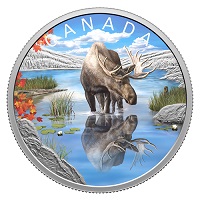
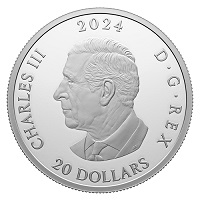
Face Value: 20 dollars … Composition: 99.99% pure silver; Mintage: 7,500; Weight: 31.39 g; Diameter: 38 mm; Edge: Serrated; Finish: Proof; Artist: Claude Thivierge (reverse); Steven Rosati (obverse); Packaging: Black clamshell with black beauty box.
DID YOU KNOW? … ***Moose tend to stick close to various water sources within forested areas. It will swim to cool off on a hot day or wade in water to find food, even diving to the bottom of a lake to feed on aquatic plants.
Designed by wildlife artist Claude Thivierge, your coin’s reverse captures the beauty and colours of a bright fall day in the Canadian wilderness, where the engraved forest and rocks serve as a backdrop. Selective colour extends to the vegetation surrounding the adult bull moose and to its reflection in the water below, while a multi-texture effect mimics the look of fur and creates a shimmering effect on the water surface. The obverse features the effigy of His Majesty King Charles III by Canadian artist Steven Rosati.
Claude Thivierge, Artist … “I wanted the moose to exude serenity and grandeur, to let the raw power and strength of its massive antlers shine through. The artistic interpretation focuses on the moose’s calm nature and the blue sky and water, which bring softness and unity to the scene, highlighting this magnificent creature.”
Alicia Cook Sapene, Product Manager … “Home to an incredible diversity of life, the Canadian wilderness is a place of perpetual beauty – a place where discoveries and unexpected encounters can provide soul-stirring moments of tranquility and reflection. With this series, I set out to celebrate Canada’s natural beauty through colourful yet contemplative portraits, and Claude brought this vision to life with his depictions of iconic wildlife in equally iconic settings.”


$1 Fine Silver Coin – Emanuel Hahn’s
Original Sketch: Parliament
www.mint.ca
Get a glimpse of the creative process behind the 1939 silver dollar. Another Mint first! We’re simultaneously honouring history and making history with this innovative thin 5 oz. coin, which brings you an engraved representation of Emanuel Hahn’s original sketch of the 1939 silver dollar. Working off the hand-drawn mock-up preserved in the National Currency Collection of the Bank of Canada, engravers have painstakingly re-created Hahn’s preliminary “Parliament” art concept for the commemoration of the royal visit of King George VI—whose effigy appears on the obverse—and Queen Elizabeth. Every pencil mark, and even the fold lines of the original paper document, are etched upon your coin’s reverse, where the relief—struck incuse for that hand-drawn look—honours both the artist and the artwork that holds historical significance. Drawn by Hahn: Enjoy an “early” view of the 1939 silver dollar.
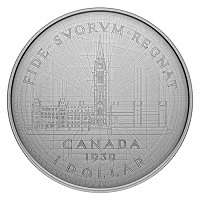
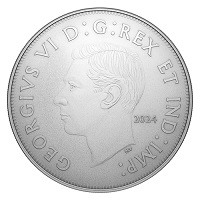
Face Value: 1 dollar … Composition: 99.99% pure silver; Mintage: 1,350; Weight: 158.5 g; Dimensions: 110 mm; Edge: Serrated; Finish: Antique finish; Artist: Emanuel Hahn (reverse), T. H. Paget (obverse); Packaging: Black clamshell with black beauty box.
DID YOU KNOW? … *** Issued in honour of the royal visit of King George VI and Queen Elizabeth—the first visit by a reigning monarch of Canada—the 1939 silver dollar was the second commemorative silver dollar issued by Canada and designed by Emanuel Hahn. His iconic Voyageur design made its debut on the first one: the 1935 silver dollar commemorating the Silver Jubilee of King George V.
Your coin’s reverse is an engraved representation of an early pencil sketch of the 1939 silver dollar designed by artist Emanuel Hahn (1881-1957). Marked by the paper fold lines of the original sketch residing in the National Currency Collection of the Bank of Canada, the reverse design is a partially completed depiction of the Parliament buildings in Ottawa, along with perspective lines and other preliminary graphic elements hand-drawn by the artist, including the Roman-style lettering for the Latin legend “FIDE SVORVM REGNAT” (“He reigns by the faith of his people”). The obverse features the historical effigy of George VI by Thomas Humphrey Paget.
Melanie Luis, Product Manage … It’s always a thrill to see a piece of numismatic history come alive on a coin, especially when its design offers rare insight into the artist’s original vision for a now-iconic piece. We’ve effectively turned back time on both sides of the coin to transport the viewer to 1939, but we’re also making history with this thin 5 oz. coin, which is the first to feature engraved relief that isn’t raised—those lines are intentionally struck incuse and precisely rendered to mimic the sketching style of the renowned artist/sculptor/coin designer.
David Bergeron, Curator, Bank of Canada Museum … Beyond the coins in our pockets, Emanuel Hahn’s legacy in numismatics has forever been preserved through the transfer of his portfolio of original coin sketches to the National Currency Collection of the Bank of Canada in 1963. Having examined Mr. Hahn’s designs, and comparing them to the actual coins, I was most impressed to see the attention to detail in his pencil sketch of Centre Block of Parliament in Ottawa, Canada for the reverse of the 1939 commemorative dollar. It is a work of art, a feat of expert draftsmanship, and is a befitting theme for the Royal Canadian Mint’s first attempt at a new process of coin design and production. The etching on a large silver planchet with antique finish really captures Hahn’s craft.
Steven Stewart, 3D Artist/Engraver … This coin is a unique inversion of how we, as engravers, would approach artwork. Usually, engraving is about the translation of a two-dimensional piece of artwork into a three-dimensional form, while adding nuance and detail to turn that concept into a physical object. With this coin, we wanted to feature the original artwork itself, as both a representation of the artistic process and also a look behind the scenes of the first stages of coin making. The sculpting approach was to treat every line as if it were made by a pencil: instead of being raised, they act as an imprint on the coin surface, where the aim is to celebrate the subtleties of notation, drafting, editing and, most importantly, mark making.

Specimen Set – Northern Leopard Frog
www.mint.ca
The loss of even a small species can have big consequences for its surroundings, and so it is with the northern leopard frog—as an indicator species, its wellbeing speaks volumes about the health of wetland ecosystems.
Depicted on the 2024 Specimen Dollar, the northern leopard frog was once widespread, but in Western Canada, populations have been in sharp decline due to disease, habitat loss and degradation, and the introduction of invasive species. The Rocky Mountain population in British Columbia has been designated “endangered” by the Committee on the Status of Endangered Wildlife in Canada (COSEWIC) but there’s some good news: the B.C. Northern Leopard Frog Recovery Team are working to prevent this amphibian’s local extinction. As part of this team, the Wilder Institute supports head-starting efforts, a conservation breeding program and wild-to-wild translocations. Together with their partners, the Wilder Institute is giving northern leopard frog populations a much needed helping hand and a shot at bouncing back. The 2024 Specimen Dollar features one of British Columbia’s most at-risk species. Mintage: 30,000; Finish: Specimen; Packaging: Book-style packaging with removable lens; Series: Set.
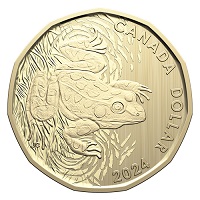
DID YOU KNOW? … *** The only remaining population of northern leopard frogs in British Columbia is located in a protected area: the Creston Valley Wildlife Management Area in south-central B.C. *** The semi-aquatic northern leopard frog plays an important ecological role by transferring nutrients between aquatic and terrestrial ecosystems.
The set-exclusive specimen dollar features a reverse design by artist Julius Csotonyi. Its depiction of a northern leopard frog (Lithobates pipiens) shows the amphibian partially submerged in its wetland habitat, where it gently rests on aquatic vegetation, such as Ceratophyllum demersum. The obverse features the effigy of His Majesty King Charles III by Canadian artist Steven Rosati.
Julius Csotonyi, Artist … This portrayal underscores both the importance of preserving both terrestrial and aquatic ecosystems necessary for the survival of the northern leopard frog, and also how fragile it is, as its weight barely registers on the vegetation on which it rests. Yet, its fingers and toes also brace against the plants, indicating how it absolutely requires other species in its environment to support it ecologically, and how we must think in terms of the connectivity of ecosystems when we endeavour to protect them.
Rebecca Stanton, Interim Conservation Research Population Ecologist, Wilder Institute … While the northern leopard frog might be a small animal, it holds a large place in my heart with everything that makes it so unique, especially its iconic song. Many British Columbia wetlands are currently missing the sounds of their chuckles and snores. I’m extremely proud to be part of the larger B.C. Northern Leopard Frog Recovery Team working to bring their song back across their historical range in the province. We’re excited that this coin shares the story of the northern leopard frog and will help the species make its way into the hearts of many other Canadians.
Caitlin Spade, Manager of Animal Care at the Archibald Biodiversity Centre and Wildlife Conservation Centre, Wilder Institute … Conservation breeding comes along with a whole range of questions. How do we maintain and diversify genetics? How can we maximize animal welfare? What habitat requirements would best mimic the species’ wild home? At the Wilder Institute, we’re committed to answering these questions for the northern leopard frogs in our conservation breeding program. With every tadpole or frog that enters our facility, we look forward to learning more about how we can create a more hopeful future for this species.


2024 … $5 Pure Silver Coin –
The Majestic Polar Bears (Premium Bullion)
www.mint.ca
Premium Bullion: Rarity, purity and quality assured. Continuing the narrative established on the first (2022) Premium Bullion in special packaging, the 2024 edition features a tender scene of a polar bear and her almost independent cub nuzzling in their Arctic habitat.
Designed for collectors and investors alike, each coin has been crafted in 99.99% pure silver with a minimum guaranteed weight of one ounce. It comes in a card holder that provides an unobstructed view of the coin’s remarkable features, including the dazzling sunburst finish and paw print markings on the reverse, and the Canadian effigy of His Majesty King Charles III on the obverse. Direct from the Royal Canadian Mint, Premium Bullion puts the purest precious metals in your hands.

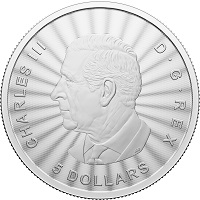
Good to know … *** Specially handled during the manufacturing process. Produced with a guaranteed weight, each uncirculated Premium Bullion coin was specially handled during the manufacturing process and comes in Royal Canadian Mint-authorized packaging. On the back of the card, an easy-to-scan QR code is a quick link to an informative website, love SILVER that welcomes the reader to the world of bullion. *** Paw print markings. The polar bear paw prints on each coin’s reverse are a collection-wide design feature and are exclusive to this line of Premium Bullion coins. *** New effigy. Each coin features the Canadian effigy of His Majesty King Charles III, marking a new royal era for Canada’s coins. *** Sunburst finish. Vivid radial lines fill the field to create a dynamic sunburst finish, which adds movement and energy to the Arctic scene. *** The world’s purest precious metals in an easy-to-collect format. Each coin is encapsulated in card packaging and wrapped in a clear envelope. *** Easy purchase option. While bullion products are typically purchased from authorized dealers, Premium Bullion is only available in this stylish card format and can be purchased directly from the Royal Canadian Mint, Canada Post and dealers. *** Fine silver. Your Premium Bullion coin is crafted in 99.99% pure silver with a minimum guaranteed weight (1 oz.) and a limited mintage of 20,000 coins worldwide. *** Premium Bullion Majestic Polar Bears coins are available in one ounce of pure silver and 1/10 ounce of pure (24-karat) gold.
Did you know? … A polar bear cub stays with its mother for the first two or three years of life. Once it strikes out on its own, the subadult faces many challenges as it continues to hone its hunting skills, but survival rates improve once it reaches adulthood and is ready to mate—that’s four to six years of age for females, while the prime breeding years for males begin around age 10.
About the design … Your pure silver Premium Bullion coin is encapsulated and protected in card. On the back of the card, an easy-to-scan QR code is a quick link to an informative website, love SILVER that welcomes the reader to the world of bullion.
Reverse: Polar bear mother and cub … The reverse design by Canadian artist W. Allan Hancock shows a polar bear (Ursus maritimus) mother and her almost independent cub nuzzling in their Arctic habitat. Paired with paw print markings that reflect the theme, the tender scene is set against radial lines that create a dramatic sunburst finish, while the coin’s purity and weight, the word “CANADA” and the year “2024” are all inscribed along the outer edge.
Obverse: His Majesty King Charles III … The obverse features a sunburst finish behind the effigy of His Majesty King Charles III by Canadian artist Steven Rosati. Composition: 99.99% Pure Silver; Mintage: 20,000; Artist: W. Allan Hancock; Finish: Bullion with sunburst finish; Diameter: 38 mm; Weight: 31.11 g.

2024 … $5 Pure Gold Coin –
The Majestic Polar Bears (Premium Bullion)
www.mint.ca
Premium Bullion: Rarity, purity and quality assured. Continuing the narrative established on the first (2022) Premium Bullion in special packaging, the 2024 edition features a tender scene of a polar bear and her almost independent cub nuzzling in their Arctic habitat.
Designed for collectors and investors alike, each investment-grade coin has been crafted in 24-karat (99.99% pure) gold with a minimum guaranteed weight of 1/10 ounces. It comes in a card holder that provides an unobstructed view of the coin’s remarkable features, including the dazzling sunburst finish and paw print markings on the reverse, and the Canadian effigy of His Majesty King Charles III on the obverse. Direct from the Royal Canadian Mint, Premium Bullion puts the purest precious metals in your hands.
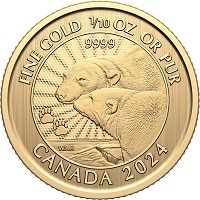
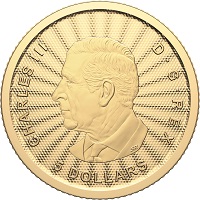
Good to know … *** Specially handled during the manufacturing process. Produced with a guaranteed weight, each uncirculated Premium Bullion coin was specially handled during the manufacturing process and comes in Royal Canadian Mint-authorized packaging. On the back of the card, an easy-to-scan QR code is a quick link to an informative website, love GOLD that welcomes the reader to the world of bullion. *** Paw print markings. The polar bear paw prints on each coin’s reverse are a collection-wide design feature and are exclusive to this line of Premium Bullion coins. *** Sunburst finish. Vivid radial lines fill the field to create a dynamic sunburst finish, which adds movement and energy to the Arctic scene. *** New effigy. Each coin features the Canadian effigy of His Majesty King Charles III, marking a new royal era for Canada’s coins. *** The world’s purest precious metals in an easy-to-collect format. Each coin is encapsulated in card packaging and wrapped in a clear envelope. *** Easy purchase option. While bullion products are typically purchased from authorized dealers, Premium Bullion is only available in this stylish card format and can be purchased directly from the Royal Canadian Mint, Canada Post and dealers. *** Signed by the Mint’s Chief Assayer, the assay certificate printed on the back of the card certifies the coin’s authenticity and gold purity. Your pure gold Premium Bullion coin is crafted in 24-karat (99.99% pure) gold with a minimum guaranteed weight (1/10 oz.) and a low mintage of just 4,000 coins worldwide. *** Premium Bullion Majestic Polar Bears coins are available in one ounce of pure silver and 1/10 ounce of pure (24-karat) gold.
Did you know? … A polar bear cub stays with its mother for the first two or three years of life. Once it strikes out on its own, the subadult faces many challenges as it continues to hone its hunting skills, but survival rates improve once it reaches adulthood and is ready to mate—that’s four to six years of age for females, while the prime breeding years for males begin around age 10.
About the design …Your pure gold Premium Bullion coin is encapsulated and protected in card packaging that includes a printed assay certificate on the back of the card. Also on the back of the card, an easy-to-scan QR code is a quick link to an informative website, love GOLD that welcomes the reader to the world of bullion.
Reverse: Polar bear mother and cub … The reverse design by Canadian artist W. Allan Hancock shows a polar bear (Ursus maritimus) mother and her almost independent cub nuzzling in their Arctic habitat. Paired with paw print markings that reflect the theme, the tender scene is set against radial lines that create a dramatic sunburst finish, while the coin’s purity and weight, the word “CANADA” and the year “2024” are all inscribed along the outer edge.
Obverse: His Majesty King Charles III … The obverse features a sunburst finish behind the effigy of His Majesty King Charles III by Canadian artist Steven Rosati. Composition: 99.99% Pure Gold; Mintage 4,000; Artist: W. Allan Hancock; Finish: Bullion with sunburst finish; Diameter 16 mm; Weight 3.11 g.


2024 … $50 Pure Silver Diamond Shaped Coin –
De Beers Ideal Cushion Diamond
www.mint.ca
Our highly sought-after series of diamond-shaped coins continues with this ode to the CUSHION cut. No other diamond shape rivals the intensity of a cushion cut’s fire. Coveted for its timeless allure and sparkle, the classic pillow-like shape – one of the oldest diamond shapes – inspired this mesmerizing 99.99% pure silver coin, the fourth in a series of diamond-topped, diamond-shaped coins. Each collectible has been masterfully sculpted to match the patented cut of the 0.23 carat* De Beers Ideal cushion cut diamond embedded on one of its facets, where the precious stone’s flashes of coloured light add flair to a storied silhouette that is synonymous with royalty and romance. Add a cushion cut diamond to your collection with Coin #4!
Good to know … *** Coin #4. Like the 2020 (square cut), 2021 (round cut) and 2022 (oval cut) offerings, this 99.99% pure silver coin celebrates the incomparable beauty of a Canadian diamond by perfectly replicating a classic diamond shape: a cushion cut. *** Topped with Canadian sourced diamond. Embedded on one of the coin’s sculpted facets, the 0.23-carat De Beers Ideal Cushion Cut Diamond and its patented cut inspired this premium collectible’s multi-dimensional shape and facet arrangement. *** Low mintage, high demand. Only 600 coins are available and all our previous Diamond Shaped coins sold out quickly, so don’t wait – order today. *** The collaboration continues. This magnificent collectible combines world-class engraving with Crossworks Manufacturing’s exclusive patented diamond cuts, as well as the sophisticated elegance of De Beers certified diamonds. *** Specially marked diamond. Each individual diamond bears a mark identifying it as a DeBeers certified diamond. *** A tradition of fine craftsmanship. Getting the right diamond shape, with its many precisely angled facets, is an enormous undertaking. All the coins in this series are a testament to the ingenuity and skill of the Royal Canadian Mint’s R&D and engraving teams. *** Special capsule. Your coin comes enclosed in a 3D diamond-shaped capsule that protects your new luxury showpiece and ensures an eye-catching presentation from start to finish. *** Comes with two certificates. The Royal Canadian Mint certifies all of its collector coins, including this spectacular piece, which comes with two certificates: a serialized one certifying your coin’s authenticity, and another from Cross works Manufacturing for the diamond.
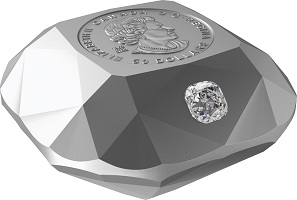
Face Value: 50 dollars … Composition: 99.99% pure silver with a 0.23-carat De Beers Ideal Cushion Cut Diamond; Mintage: 600; Weight: 80.455 g; Dimensions: Length: 28.7 mm, Width: 28.7 mm, Height: 21.4 mm; Edge: Plain; Finish: Matte Proof; Artist: RCM Engravers (reverse), Susanna Blunt (obverse); Packaging: Black clamshell with black beauty box.
Did you know … *** Today’s cushion cut is a modern iteration of the Old Mine cut, the most common shape until the late 19th century. Yielding squarish stones with a higher crown and a deeper pavilion, the faceting style maximized carat retention and took less time to execute than the modern cushion cut’s 64 facets.
About the design … Your coin is enclosed in a diamond-shaped capsule and presented in a Royal Canadian Mint-branded clamshell with a black beauty box.
Multi-faceted design and diamond … Your coin’s unique shape and multi-faceted design are a reproduction of a patented trademark diamond cut from Cross works Manufacturing, as seen on De Beers Ideal Cut Diamonds. Embedded on one of the crown main facets, is a 0.23 carat* De Beers Ideal Cushion Cut Diamond. This coin has the added distinction of featuring a piece of Canada’s mining history: its diamond having been sourced from one of Canada’s finest diamond mines. The year “2024” is engraved on another crown main facet, while the word “CANADA”, the denomination of “50 DOLLARS” and the effigy of Her Majesty Queen Elizabeth II by Susanna Blunt appear on the largest facet (the table). The obverse also bears a special marking that includes four pearls symbolizing the four effigies that have graced Canadian coins and the double date of her reign.

2024 … Pure Gold Diamond-Shaped Coin –
De Beers Ideal Cushion Diamond
www.mint.ca
Our highly sought-after series of diamond-shaped coins continues with this pure gold ode to the CUSHION cut. No other diamond shape rivals the intensity of a cushion cut’s fire. Coveted for its timeless allure and sparkle, the classic, pillow-like shape – one of the oldest diamond shapes – inspired this spellbinding 99.99% pure gold coin, the fourth in a series of diamond-topped, diamond-shaped coins. Each coin has been masterfully sculpted to match the patented cut of the 0.23 carat De Beers Ideal Cushion Cut diamond embedded on one of its facets, where the precious stone’s flashes of coloured light add flair to a storied silhouette that is synonymous with royalty and romance. Add a cushion cut diamond to your collection with Coin #4!
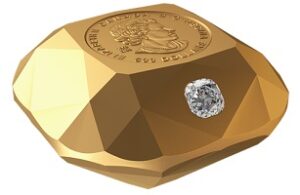
Face Value: 500 dollars … Composition: 99.99% pure gold with a 0.23-carat De Beers Ideal Cushion Cut Diamond; Mintage: 150; Weight: 148 g; Dimensions: Length: 28.7 mm, Width: 28.7 mm, Height: 21.4 mm; Edge: Plain; Finish: Matte Proof; Artist: RCM Engravers (reverse), Susanna Blunt (obverse); Packaging: Black clamshell with black beauty box.
DID YOU KNOW? … Today’s cushion cut is a modern iteration of the Old Mine cut, the most common shape until the late 19TH century. Yielding squarish stones with a higher crown and a deeper pavilion, the faceting style maximized carat retention and took less time to execute than the modern cushion cut’s 64 facets.
Your coin’s unique shape and multi-faceted design are a reproduction of a patented trademark diamond cut from Cross works Manufacturing, as seen on De Beers Ideal Cut Diamonds. Embedded on one of the crown main facets, is a 0.23 carat* De Beers Ideal Cushion Cut Diamond. This coin has the added distinction of featuring a piece of Canada’s mining history: its diamond having been sourced from one of Canada’s finest diamond mines. The year “2024” is engraved on another crown main facet, while the word “CANADA”, the denomination of “50 DOLLARS” and the effigy of Her Majesty Queen Elizabeth II by Susanna Blunt appear on the largest facet (the table). The obverse also bears a special marking that includes four pearls symbolizing the four effigies that have graced Canadian coins and the double date of her reign.


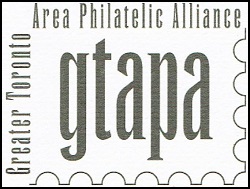
www.gtapa.org
The GTAPA is committed to promote
and stimulate the art of philately to all ages
for fun, culture, education and friendship.

